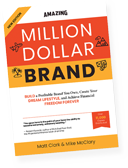One Size Does NOT Fit All – PART 2
One size fits all is usually one size fits nobody.
Whether it’s the optimal diet, the optimal way to run a business, or the optimal way to create happiness, no one single solution is best for everyone.
We’re all different.
Tailoring your approach to your uniqueness is the key to faster and longer-lasting results.
This is the second part of a three-part series I’m sharing with you on what I’ve discovered by digging deep into the research produced by the field of positive psychology.
For the first time ever, rigorous academic research is being applied to how we thrive as human beings – in short, how to be happy.
In the first part of the series, Stop “Looking” For Happiness, I shared that research shows you create happiness, you don’t find it. By what you do on a daily basis, you impact the 40% of what you control that makes up your overall happiness.
Your circumstances – what you achieve, where you live, who you’re with, how much money you have – only affect 10% of your happiness.
Therefore, it makes sense to figure out the 40%, which, by the way, research has shown leads togreater productivity and success – and, yes, more wealth.
Most self-help books have taught one size fits all approaches to improving our lives.
According to the books, you need to…
Strive for goals,
Amp yourself up every morning by screaming motivational phrases,
Just mentally “attract” what you want in life,
Wake up at 4:30AM every day,
Just say “f*ck it” and stop caring about what other people think,
Find your passion,
Practice gratitude,
Build habits,
Network, find a mentor, and get around successful people,
And on and on and on…
The problem is, one size does not fit all.
If you’re an introvert and a book is telling you the only way to be happy is to express deep, heartfelt gratitude face-to-face to those you care about, it’s going to be an uphill battle.
Conversely, that exact strategy may work wonders if you’re an extrovert and love being around people.
If you’re an introvert, an easier strategy might be to nurture an optimistic attitude by writing about what you want to accomplish in the future.
Both strategies are equally as effective, but one is likely easier and more natural depending on who you are.
The book The How of Happiness by positive psychology researcher Sonja Lyubomirsky, provides the following twelve happiness creating activities:
1. Expressing gratitude
2. Cultivating optimism
3. Avoiding overthinking and social comparison
4. Practicing acts of kindness
5. Nurturing social relationships
6. Developing strategies for coping
7. Learning to forgive
8. Increasing flow experiences
9. Savoring life’s joys
10. Committing to your goals
11. Practicing religion and spirituality
12. Taking care of your body through meditation, physical activity, or acting like a happy person
The cool part is, all of these have research supporting their effectiveness.
You just choose which ones are most natural to you and do those.
You don’t have to “stretch yourself” or force yourself to do activities that are so far outside your comfort zone you won’t do them. Start with the activities you’re most comfortable with and do at least one on a daily basis.
Little by little, you’ll get more and more comfortable – and happy. Eventually, you may want to try some of the other activities that make you a little more uncomfortable.
Either way, you’ll be improving your well-being along the way in as little as just a few minutes a day.
Now that you understand you can create happiness on a daily basis by choosing to take small steps in changing your thinking and acting and you know you can use strategies that work for you, what’s left?
After reading positive psychology research, I came to realize that multiple resources, even outside this field, are converging on one central problem getting in the way of our well-being…
In fact, according to research, doing just one simple thing that the majority of working adults likely do every day can produce the same effect as dropping your IQ by 10 points.
For comparison, not sleeping for 36 hours produces the same effect.
And this is just one example of how we’re unknowingly sabotoging our productivity and well-being.
In the final part of this series, I’ll share with you what I’ve learned from reading and my own experience about how to increase productivity, success, and well-being by focusing on one important, non-renewable resource.
Thanks for reading 🙂
Find your first--or next--product to sell fast
Discover top-selling products on Amazon. See accurate sales trends and profit estimates so your next product succeeds. Plus, plan out your entire product and brand with a new custom AI tool unavailable anywhere else.
Heading 1
with a request body that specifies how to map the columns of your import file to the associated CRM properties in HubSpot.... In the request JSON, define the import file details, including mapping the spreadsheet's columns to HubSpot data. Your request JSON should include the following fields:... entry for each column.


